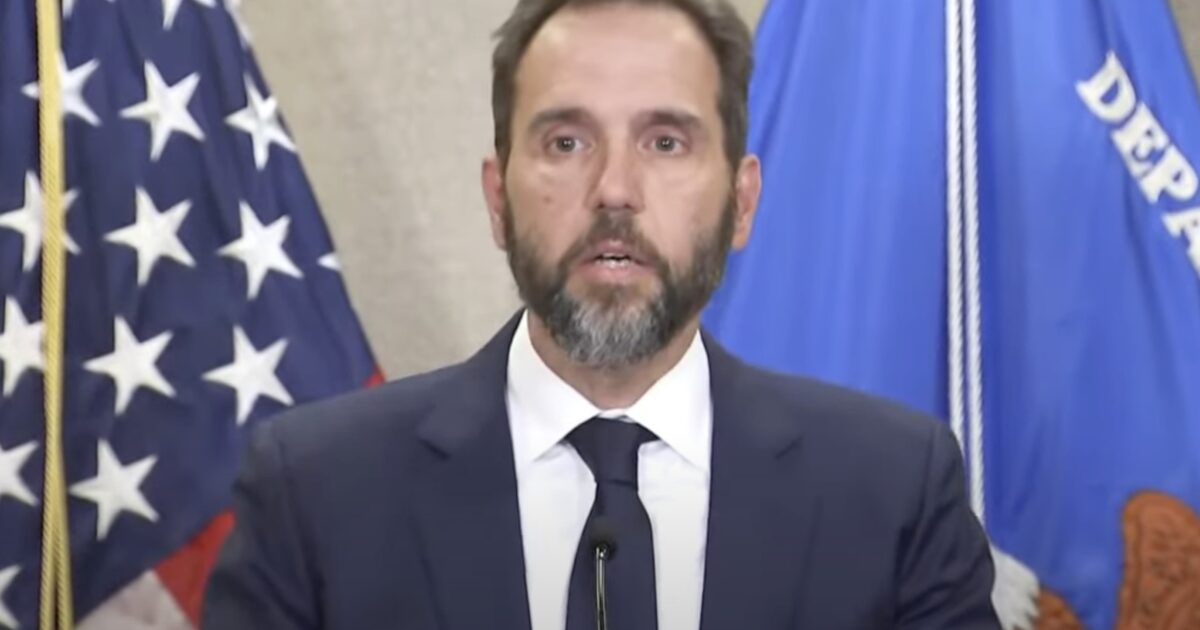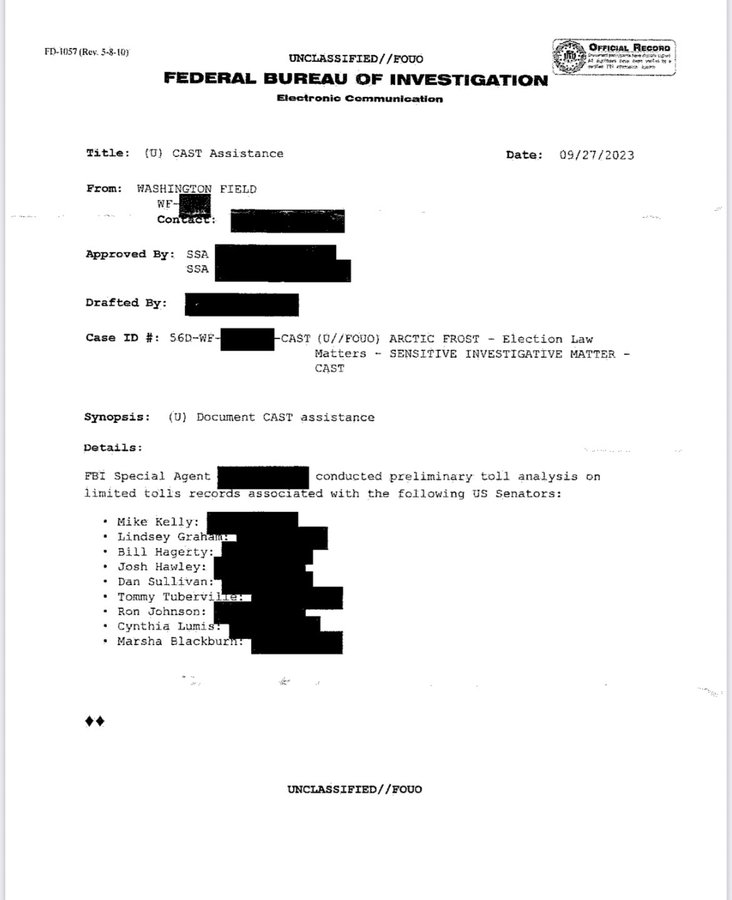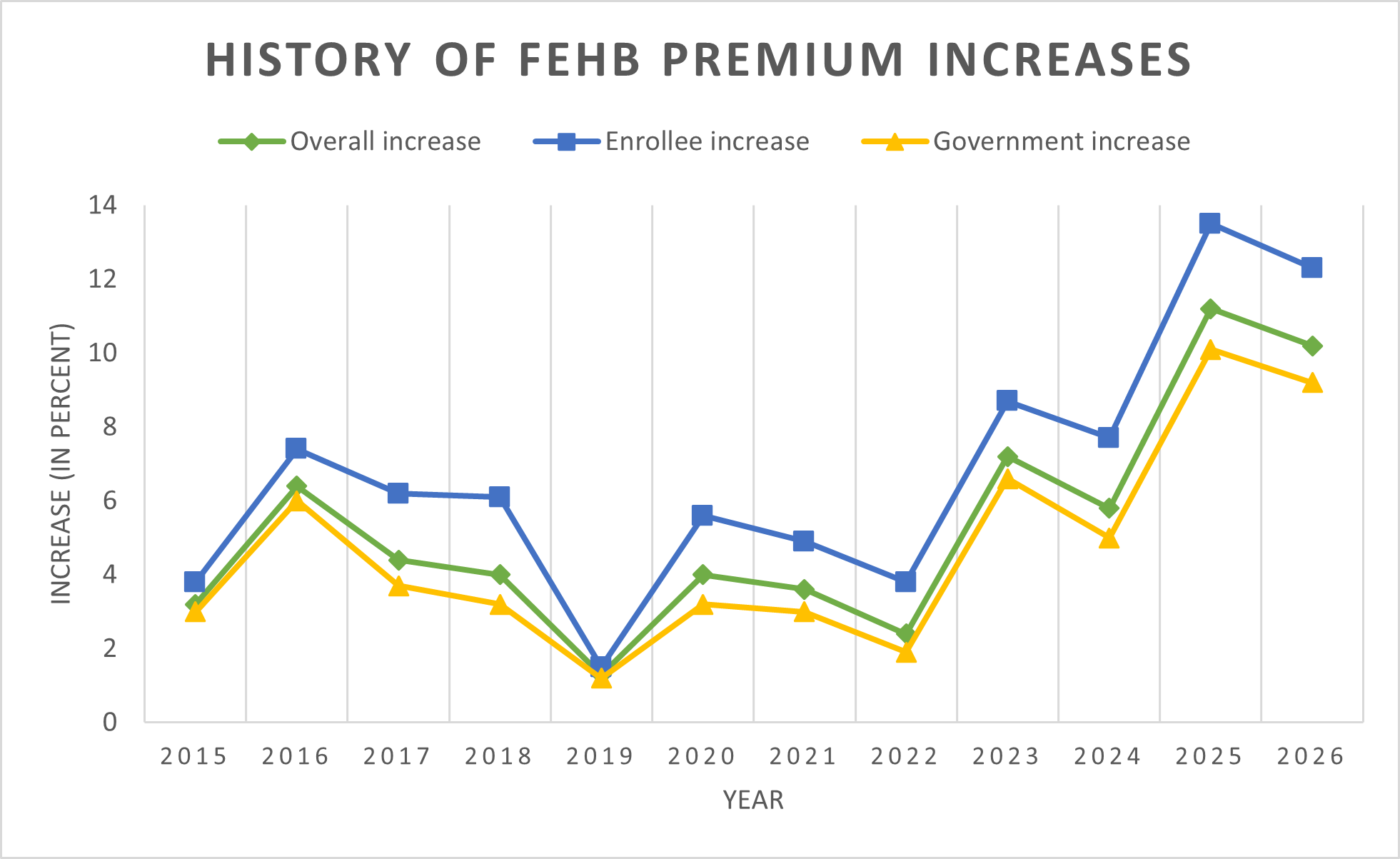Politics
NEW: FBI Fires Two Agents Who Worked For Jack Smith

The FBI took action against three FBI officials who worked for Jack Smith, firing two, after it was revealed that Biden’s FBI – and Jack Smith – spied on several Republican Senators.
According to NBC News, one of the fired FBI agents was months away from retirement.
Joe Biden’s FBI – and later Jack Smith – spied on eight Republican Senators during the ‘Arctic Frost’ investigation into January 6.
Republican Senators Chuck Grassley and Ron Johnson earlier this year released new records detailing the FBI and DOJ’s sweeping investigation that formed the basis of Jack Smith’s DC case against President Trump.
Grassley and Johnson previously blew the lid off another sham investigation orchestrated by Biden’s corrupt Department of Justice and compromised FBI.
According to the documents released earlier this year, the FBI and DOJ weaponized their power to target President Trump, former Vice President Mike Pence, and their allies through a probe dubbed “Arctic Frost.”
“Operation Arctic Frost” was a taxpayer-funded witch hunt launched in April 2022 that seized government-issued cell phones belonging to Trump and Pence while conducting a barrage of interviews across the country.
Jack Smith tracked private phone calls of eight GOP Senators.
Here’s the list:
 FBI, Jack Smith spied on Republican Senators and tracked their calls
FBI, Jack Smith spied on Republican Senators and tracked their calls
FBI Director Kash Patel previously said he fired those who ‘acted unethically’ but it was unclear how many agents he terminated.
They tracked the communications of GOP Senators. They weaponized law enforcement against the American people. That era is over.
We fired those who acted unethically, dismantled the corrupt CR-15 squad, and launched an investigation.
Transparency and accountability aren’t… pic.twitter.com/2vRlZrA20R
— FBI Director Kash Patel (@FBIDirectorKash) October 7, 2025
NBC News reported:
The FBI took personnel action against three special agents who worked in connection with former special counsel Jack Smith’s probe of Donald Trump, firing at least two, three people familiar with the matter told NBC News.
All three agents were previously named in documents released by Sen. Chuck Grassley, R-Iowa, about “Arctic Frost,” an FBI probe that was the precursor to the Smith investigation, which resulted in two federal criminal cases against Trump: one for his handling of classified documents and the other involving his attempts to overturn his 2020 election loss, which ended in the Jan. 6 attack on the U.S. Capitol.
One of the fired FBI employees, a combat veteran who was months away from becoming eligible for retirement, was called back to the office after having left for the day and informed of the dismissal, a person familiar with the matter told NBC News. The other dismissed agent was also called back to the office after having left for the day, the person said.
The post NEW: FBI Fires Two Agents Who Worked For Jack Smith appeared first on The Gateway Pundit.
Politics
HUNGARIAN WITCH HUNT: After Ukraine Accused Orbán of Sending Drones Into Its Airspace, Now the European Union Is Investigating an Alleged Hungarian Spy Ring in Brussels

Ursula von de Leyen is coming for Viktor Orbán.
‘Everything is Hungary’s fault’.
There’s a new illness of the mind going around the Globalist corners of the European Union.
You can call it Hungarophobia or Magyarophobia, and it basically means that the conservative central European country is receiving the ‘Russian treatment’, with constant psyops and disinformation against it.
Around 10 days ago, Kiev regime leader Volodymyr Zelensky publicly accused Budapest of deploying multiple drones into Ukrainian airspace – a serious accusation never backed with any data, and soon dropped into oblivion.
Now, the Globalist archfoes of the European Union have broken another ‘sensational story’ against Viktor Orbán and his government.
Watch: Commission spokesperson Balázs Ujvári.
Orban has crossed a red line!
The European Commission probes Hungarian spy network in Brussels.According to reports that sparked the probe, the undercover spy ring allegedly operated under the cover of the Hungarian permanent representation, which at that time was led by… pic.twitter.com/Lc3oDaVG8a
— Yasmina (@yasminalombaert) October 9, 2025
Euronews reported:
“According to reports that sparked the probe, the undercover spy ring allegedly operated under the cover of the Hungarian permanent representation, which at that time was led by Olivér Várhelyi, who is now a European Commissioner.
The European Commission launched a probe on Thursday after several media reports alleged that the Hungarian secret services were trying to recruit EU employees in Brussels as informants.”
 Orbán is the man Globalists in Brussels love to hate.
Orbán is the man Globalists in Brussels love to hate.
The agents would have posed as diplomats of the Hungarian Permanent Representation to the EU in Brussels.
The spies allegedly targeted Hungarian staff at the European Commission.
“’We will be setting up an internal group to look into those allegations’, Commission spokesperson Balázs Ujvári said.
Earlier, Hungary’s Direct36, together with German outlet Paper Trail Media and Belgium’s De Tijd newspaper, reported that Hungarian intelligence services were allegedly trying to recruit Hungarians working in EU institutions to build a network.”
Read more:
Budapest Says Zelensky ‘Is Losing His Mind’ After Allegations of Hungarian Drones Invading Ukrainian Airspace
The post HUNGARIAN WITCH HUNT: After Ukraine Accused Orbán of Sending Drones Into Its Airspace, Now the European Union Is Investigating an Alleged Hungarian Spy Ring in Brussels appeared first on The Gateway Pundit.
Politics
House’s zero trust journey is more process than technology update

The House of Representatives started its journey to push security to the edge by first looking internally.
With hundreds of end points in member offices across the country, House technology leaders had to take stock of what cyber tools they were already using.
Jamie Crotts, the chief information officer for the House of Representatives, said that initial assessment of its current state of cyber tools and how they fit into the zero trust model was the first step in their improving the overall cyber posture of the lower chamber of Congress.
Jamie Crotts is the chief information officer for the House of Representatives.
“We plan on a three-year technology roadmap cycle. So it’s about understanding which step is the next best step to get us the most benefit for the architecture and for our users. And from that point, we adjusted our roadmap and our planning,” Crotts said on Ask the CIO. “We began budgeting for some of the larger items that are going to be more long term, and we began implementing things that we could do immediately, that were more quick wins, if you will, and that’s still where we are.”
While the House doesn’t have to meet the executive branch mandates under zero trust, Crotts said the maturity models developed by the Cybersecurity and Infrastructure Security Agency and Defense Department are helping to guide their efforts.
The initial zero trust assessment mapped against their current IT roadmap, which is broader than just cybersecurity, led to some adjustments for current and future planning as well as where to invest its limited budget.
Crotts said that mapping led the team to realize that achieving initial capabilities under zero trust was as much as about adjusting the way they did cybersecurity as it was about new tools.
“Looking at it from the users, devices, applications and the network, every single layer of that, we examined how our efforts were going to be able to make improvements. When we looked at the assessment and we saw we can get better at, say, provisioning of devices for users, we can do things a little bit differently that will get a slightly more secure device in their hands in a slightly faster time frame. That is something that would be low hanging fruit for us,” he said. “If it’s as simple as adjusting the way we do imaging to make sure it’s inclusive of certain types of tools, we would be able to take care of that without having to plan for a long-term investment that wasn’t already there. We’re not buying a new tool. We’re adjusting an existing process, and that’s most of our quick wins.”
Flexibility remains key to meeting cyber needs
At the same time, Crotts said they are optimizing existing cyber tools to push them closer key areas of zero trust.
“We spend a lot of money on these tools, whether they be cyber tools, specifically, monitoring analysis tools or general IT productivity tools, applications and suites. But we rarely take the time after we have purchased and implemented it to step back and say, ‘Are there other toggles we could adjust that give us a bit more benefit?’ So, part of our assessment from the zero trust side did exactly that,” he said. “It pointed out that we have some investments in tools giving us a bit of an overlap, which can result in a cost savings. If we identify turning on this widget and this tool actually allows us to stop buying this other tool, that’s a win. That’s essentially how we spent the last year, looking at the tools that we’ve already invested in reducing technical debt is something everybody’s trying to do. So every quick win we can get is amazing.”
Like most IT organizations, the House budgets on a multi-year cycle, so Crotts said they do their best to guess what cyber tools or IT applications they will need in a few years. He said having flexibility in existing tools and processes helps close gaps that otherwise they would have to wait for funding to address.
One example is how the House implemented cloud access security broker (CASB) capabilities.
“It might not be doing exactly what we want it to be doing, or we want to look at the way we do our web access firewalls a little bit differently or routing traffic differently coming from the far edge, things like that take a little bit more time,” he said. “We have to do that thorough analysis. We have to make an investment once we pick the right tool that’s going to work for our architecture. That’s really how we chalked up all of those things, so not necessarily by the pillar that they naturally belong in, but across all the pillars, where can we actually have the most innovative benefit for the House?”
With some initial zero trust capabilities implemented, Crotts said the next focus area is around the data pillar.
Focusing on the data pillar of zero trust
He said his team is spending a lot of time understanding their data governance model.
“Data is data, but the importance of that data is unique to the organization that creates it. Nowhere is that more true than in the legislative branch, where we have different types of data that other people don’t have to deal with, things like legislation data that’s protected by the Speech and Debate Clause of the Constitution. Those types of non-traditional data governance problems, if you will, are things that we’re trying to wrap our minds around,” Crotts said. “How do you do proper tagging of that kind of data? How do you understand the flow of that data throughout your enterprise? When it’s not as simple as tagging a Social Security Number automatically because I know what that looks like, but for some of these more ethereal concepts, it takes a real understanding.”
Crotts added that means analyzing current and possibly future tools to help manage the data as well as creating schemas that let data move securely and efficiently through the network.
“A lot of good security practices come back to the fundamentals of, can you invoke it in a policy and actually enforce it? So once we understand the data types in the data flow, and we get sort of the organizational agreement on, ‘Yes, these are the things and this is the level at which we want to want and need to protect them,’” he said. “Then setting up that structure becomes the next challenge, if you will. A lot of best security practices can be put in play there, but like everything else, you need to define it first.”
Once the House can define and manage its data, then applying a more strict version of privileged access management to further protect systems and data will be possible.
At the same time, Crotts said his team has to understand their users’ needs, of which there are thousands of people on Capitol Hill and across 900 district offices that need access to systems and data, to balance their experience with the cybersecurity requirements.
“A proper security tool configured well does not have to interrupt workflow. And that’s really key to understanding those challenges,” he said. “Every time a user has to stop and log into something else or authenticate or pull up their token numbers and reauthenticate, you have lost them. They become upset with the process, even if it’s perfectly efficient, you’ve interrupted them. You should only do that as little as possible. But then you need to trust that once they are logged into that session, that you’ve got the other controls in place to make sure that the accesses prevent them from moving laterally to a place where they shouldn’t be. If you’ve got all that in place, then you can trust that login and you don’t have to go through all those other processes.”
The post House’s zero trust journey is more process than technology update first appeared on Federal News Network.
Politics
Federal health insurance premiums to see another large spike in 2026

Federal employees and annuitants are heading for yet another year of large increases to their health insurance premiums, in both the Federal Employees Health Benefits (FEHB) program and the Postal Service Health Benefits (PSHB) program.
The Office of Personnel Management announced Thursday that FEHB participants will pay an average of 12.3% more toward their insurance premiums starting in January 2026 — or in dollars, an average of $26.40 more per pay period.
The upcoming 12.3% premium spike follows multiple large premium increases over the last few years for FEHB enrollees. Federal employees saw an average of a 13.5% increase for the 2025 plan year — the largest year-over-year increase in well over a decade. Feds also saw a 7.7% jump in 2024, and an 8.7% increase in 2023.
Graph created by Federal News Network using Office of Personnel Management data from 2015-present.
The PSHB program, which is open to more than 2 million USPS employees, annuitants and family members, is also set for a large premium increase for 2026. Enrollees in PSHB will be paying 11.3% more, on average, toward their 2026 premiums. In dollars, that’s about $21.51 more per pay period.
The federal government covers about 75% of a participant’s premium — and no more than 72% of the weighted average of the previous year’s federal health insurance premiums.
When accounting for the government’s share of FEHB costs, which is increasing by about 9.2%, premiums will rise by 10.2% overall. PSHB premiums are increasing by 9% overall, when including the government’s portion of the cost, which is going up by 8%.
Open Season during a shutdown
For this year’s announcement, federal employees are facing more uncertainty than usual. The upcoming premium increases for the government’s health insurance programs are compounded by the current shutdown, as well as the possibility of missing paychecks if the lapse in appropriations drags on.
If a shutdown extends into November, OPM has said Open Season would still go on as normal. Health benefits for federal and postal enrollees continue throughout the shutdown, but premium payments are paused for the duration of the shutdown.
Additionally, participants in FEHB, PSHB and the Federal Employees Dental and Vision Insurance Program (FEDVIP) — regardless of whether they are furloughed, excepted or exempt — can still make changes to their plan options during Open Season, even in the case of a shutdown. OPM finances those programs through a trust fund, rather than appropriations, meaning the funding is not expected to be interrupted.
But at the same time, OPM is now managing the FEHB and PSHB programs with significantly less staffing than in previous years. Due to the Trump administration’s overhauls to the federal workforce, the agency is on track to lose 1,000 employees, or about one-third of its total workforce, by the end of the calendar year.
OPM’s healthcare and insurance office, which manages FEHB, PSHB, FEDVIP and other insurance programs, has lost a total of 80 employees this year through retirements, attrition, the deferred resignation program (DRP) and probationary terminations.
Over the summer, OPM’s inspector general office warned that those staffing shortages, coupled with funding issues, put the PSHB’s central enrollment platform at risk of an operational failure. All PSHB participants must use the online platform to access their benefits and make changes to their health insurance options during Open Season.
A separate Government Accountability Office report earlier this year also found that recent OPM staffing vacancies led to a suspension of fraud risk assessments in the FEHB program.
Looking ahead to 2026
Premium rates for federal health insurance programs inevitably increase to some extent each year. Though the premium increases for enrollees average to 12.3% and 11.3% for 2026, some plan options will have smaller cost increases, while others will have bigger ones.
The large premium increase for federal health insurance also contrasts with the 1% federal pay raise President Donald Trump is proposing for most General Schedule employees in 2026.
OPM Associate Director of Healthcare and Insurance Shane Stevens noted that the premium increases aren’t as large as they were for 2025, which shows “some positive movement.”
“All that being said, we recognize that increasing health care expenses at this clip is not a sustainable path,” Stevens said in a blog post Thursday. “As we assess the overall health vs. expense equation across the US, we find an alarming trend.”
Stevens said OPM is looking to address the rising costs by cracking down on waste, fraud and abuse in the programs, as well as moving toward “a more proactive, preventive health-first orientation.”
“None of these initiatives of course will happen overnight,” Stevens said. “But, we are committed to improving the quality of life and quality of care for our members while also ensuring that healthcare remains accessible and affordable for those who work (or have worked) for the American people.”
OPM’s announcement Thursday comes about a month ahead of Open Season, the time of year that FEHB and PSHB enrollees can update their federal health insurance options for plan year 2026. This year’s Open Season runs from Nov. 10 to Dec. 8.
Any changes made during Open Season will take effect when plan year 2026 officially starts on Jan. 1. More information and resources are available on OPM’s website for both FEHB and PSHB participants.
The post Federal health insurance premiums to see another large spike in 2026 first appeared on Federal News Network.
-

 Entertainment7 months ago
Entertainment7 months agoNew Kid and Family Movies in 2025: Calendar of Release Dates (Updating)
-

 Entertainment4 months ago
Entertainment4 months agoBrooklyn Mirage Has Been Quietly Co-Managed by Hedge Fund Manager Axar Capital Amid Reopening Drama
-
Tech7 months ago
The best sexting apps in 2025
-

 Entertainment6 months ago
Entertainment6 months agoKid and Family TV Shows in 2025: New Series & Season Premiere Dates (Updating)
-

 Tech8 months ago
Tech8 months agoEvery potential TikTok buyer we know about
-
Tech8 months ago
iOS 18.4 developer beta released — heres what you can expect
-

 Tech8 months ago
Tech8 months agoAre You an RSSMasher?
-

 Politics8 months ago
Politics8 months agoDOGE-ing toward the best Department of Defense ever



